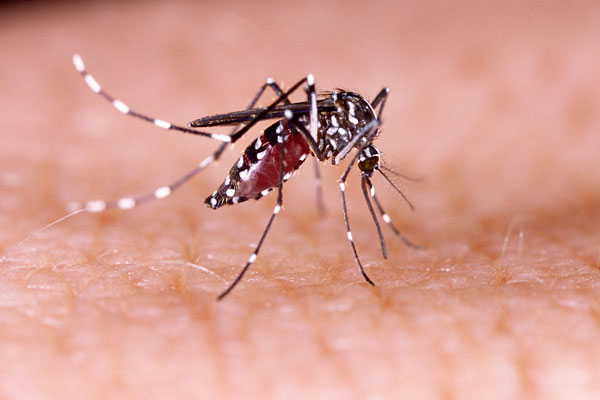Prime
Scientists plan to eliminate RVF in livestock

Dr Patrick Abila at the Insectary lab and housefly control demonstration facility explaining to stakeholders how Rift Valley Fever virus in animals and humans can be controlled to attain health livestock breeds. Photo | Lominda Afedraru
What you need to know:
- In cattle and other animals, Rift Valley Fever (RVF) causes abortion to the foetus and usually it leads to high rates of death in calves.
It is early morning and a team of scientists are heading to the National Livestock Resources Research Institute (NaLIRRI) to interact with scientists who are being visited by stakeholders on a fact finding mission. During the course of the interaction one of the interesting technologies which the donor stakeholders were amazed of is the Insectary Laboratory were scientists have confined mosquitos spreading Rift Valley Virus in animals and humans.
Rift Valley Fever (RVF) is a viral disease most commonly seen in domesticated animals in sub Saharan Africa, such as cattle, buffalo, sheep, goats and camels. Human beings can get RVF through contact with blood, body fluids or tissues of infected animals or through bites from infected mosquitoes. In livestock, RVF infections are characterised by sweeping abortion storms in female animals and up to 100 percent mortality in calves.
RVF occurrences are prevalent in the animal husbandry sector in Uganda, the reason scientists at NaLIRRI, Nakyesasa are conducting research studying the characteristics of the mosquitoes spreading the virus in a bid for farmers to use the right insecticides to eliminate them.
Background
The primary reservoir and vector for RVF is the Aedes mosquito though it can be transmitted by other mosquitoes such as Anopheles and Culex.
These mosquitos can lay infected eggs that can stay in the soil for a long period in dry conditions and hatch during wet months into infected mosquitoes. Therefore, in flooding situations, the infected eggs can be transported to new locations hence spreading the virus to different geographical locations.
The infection can also spread due to animal movements introducing infected animals to new territories.
In the animals, transmission is mainly through bites of Aedes mosquitoes. However, the disease is mainly acquired in humans through contact with blood, body fluids, or tissue and consumption of raw or undercooked milk or meat from infected animals.
This is why persons who interact with animals and their products such as veterinarians, herders, and butchers are a high-risk population for RVF. The virus was discovered in 1930 in the rift valley area in Kenya during an epidemic investigation on Sheep and it has caused multiple outbreaks in Africa and the Middle East. Since it was reported then, many epidemics have occurred in various regions including Egypt in 1977, Kenya 1997–1998, Saudi Arabia 2000 –2001, Yemen 2000–2001 and Kenya 2006-2007.
The research at NaLIRRI
Dr Patrick Abila, a research officer and entomologist at NaLIRRI heading the research explained to the stakeholders that under a project “Mosquitos blocking boosting of Uganda’s investment in livestock development (build)” his team is studying the characteristics of two mosquito species spreading Rift Valley fever in animals.
This is a three-year project done jointly with scientists at the International Livestock Research Institute (ILRI) based in Nairobi, Kenya and Free University of Berlin in Germany.
How the virus is transmitted
Abila explains that much as Anopheles mosquitos spreads Malaria in humans, Aedes Aegyptus and Culex mosquitos spread RVF in animals.
The virus is spread from the mother mosquito to the laid eggs, to the larvae, pupa and back to grown mother and Aedes mosquito is a primary transmission vector.
Culex Mosquito is a secondary vector because it picks the virus from an infected animal thereby spreading it as it goes biting animals in the grazing land. In humans in it can be transmitted in various ways including consumption of infected raw milk, beef of infected animal and infected mosquitos bites thereby causing haemorrhagic fever which may be mild and disappear or causing serious infection if not treated may lead to death depending on one’s genes.
In cattle and other animals, it causes abortion to the foetus and usually it leads to high rates of death in calves.
Incubation
The disease has an incubation period of between two and six days in humans and varies in severity; that is, some remain asymptomatic and others might experience mild illness whereas some may have severe disease. Rift Valley fever virus patients may present with fever, generalized weakness, back pain, and dizziness which can clear within seven days.
However, 10 percent can develop severe disease characterized with visual disease, encephalitis, or haemorrhagic fever. About 50 percent of those that develop severe disease either die or remain with permanent disabilities.
Outbreaks
Cases have been reported from districts of Kiboga, Mityana, Buikwe and Kiruhura districts in the cattle corridor of Uganda. This is because the main economic activity carried out in these districts is livestock farming.
Certain environmental factors such as dense vegetation, temperature conditions that favour mosquito breeding and virus replication and presence of ruminants such as cattle, sheep and goats that can amplify transmission of the virus.
Areas with a flat topography, water retaining soil types and dense bush cover are important factors for flooding and mosquitoes breeding.
Research process
Dr Abila and his team are carrying out the research at the Mosquito Insectary Laboratory at NaLIRRI. This after they went collecting the two mosquito species Isingiro, Nakyesasa, Sembabule and Lyantonde among others. Since most animals in these districts have been exposed to virus, the research is to manage the mosquito population. The scientists are keeping the mosquitos under temperature between 25-27 degrees Celsius and they are fed on born blood from the animals.
The scientists have studied that most these mosquito species resist insecticide spraying. They are introducing specific insecticides to the mosquitos and study the genes of those that die and those that resist. In case of the latter they introduce at least two or three types of insecticide and in case they die, then the farmer will be advised to combine insecticides for the species that resist one type of insecticide.




